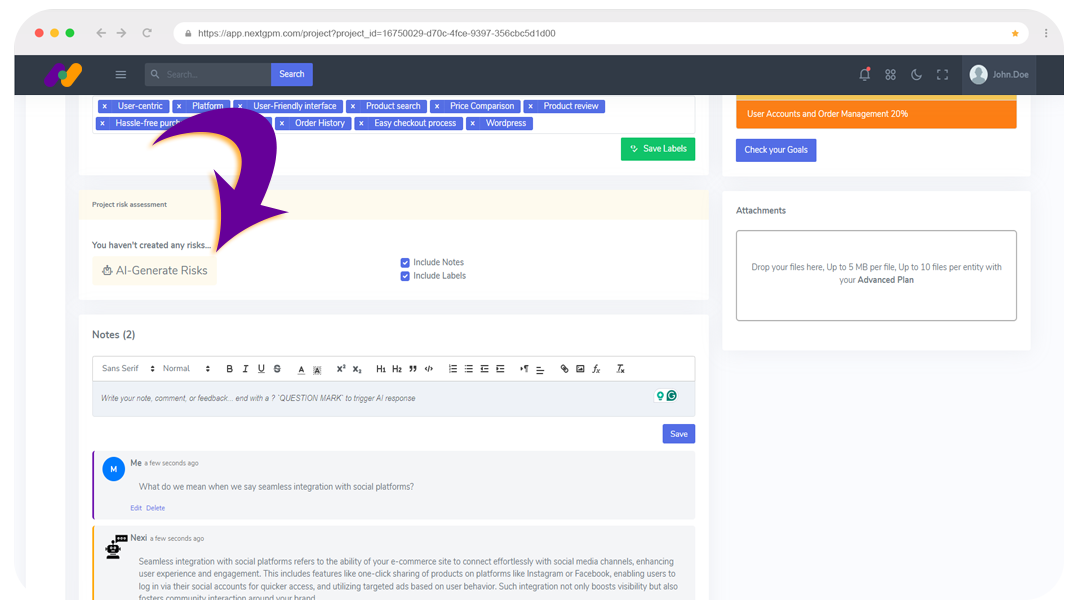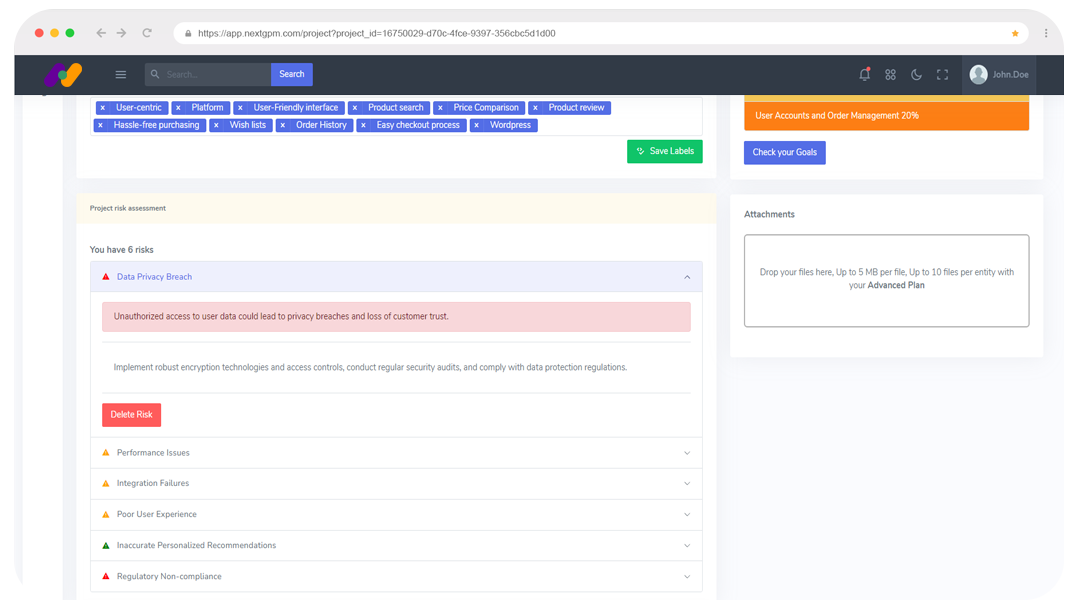AI in Project Management and Analysis: Unpacking an E-commerce Web Development Project – Part 2
July 7, 2024 4 min

Welcome to Part 2 of our comprehensive guide showcasing how NextGPM harnesses AI in E-commerce Web Development Project Management. If you are landing here first, we strongly recommend reading "Unpacking an E-commerce Web Development Project with AI – Part 1" to get the full context of this guide.
In Part 1, we laid the groundwork by describing the initial project setup, SMART goal setting, and reviewed the AI results on SMART (Specific, Measurable, Achievable, Relevant, and Time-Bound) Goal Generation. Now, in Part 2, we delve into visualization with risk assessment and the role of our interactive AI chat. Let’s continue our deep dive into project management excellence with NextGPM.
Section 1: Project Risk Assessment with AI in E-commerce Web Development
Using NextGPM’s AI-powered risk assessment feature, we conduct a comprehensive risk analysis for the entire project. This AI tool examines the project’s specifics and identifies potential risks that might be encountered during execution. These risks could range from technical issues to potential time overruns or resource availability.
Detailed Risk Identification
After identifying the risks for the overall project, we do the same at the goal level. Assessing the risks associated with each goal ensures that individual components of the project are risk-averse. If a risk linked to a goal materializes, it becomes a localized issue that we can address promptly, preventing disruption of the entire project.
NextGPM’s AI also provides mitigation strategies for each anticipated risk. These proactive strategies help us keep potential issues under control, allowing for smooth project execution.
Section 2: Identifying Risks
To identify risks along with importance levels and mitigation strategies, simply click on the AI_Generate Risks button on the project details page. This feature addresses the question: What are the main risks we might face while crafting a user-centric e-commerce platform?

At this point, you can include the project labels defined in the Project Creation Phase. If necessary, you can add new labels by typing them into the Labels section. Another option is to start using the interactive notes feature. You can ask questions, and the AI will respond, or you can collaborate with your team. If analyzing the project alone, you can write notes and thoughts on the project. Selecting “Include Notes” in the risk assessment process allows the system to identify any hidden risks and mitigate those as well.
For this example, we will consider the labels and request a project risk assessment. The process takes between 5 to 30 seconds and provides a complete risk assessment, along with mitigation strategies and risk severity.

Examining AI-Generated Risks Results
The AI-generated risks are organized and easy to examine. Each risk has an icon showing its importance, ranging from green to red. Risks are expandable for detailed reading. If a risk is not relevant or should be addressed later, it can be deleted. Here is the list of risks generated:
Section 3: Using the Interactive Notes Feature
This feature allows team members or individuals to ask questions related to their work. Think of it as a private search engine that answers questions and considers all aspects of the project at that moment.
After an early project analysis and a robust AI-aided risk assessment, you might want to ask specific questions regarding safety and threats.
Whenever you write a note ending with a question mark, the AI will respond considering the current information on the page. Here are a couple of example questions and responses:
| Question | Answer |
|---|---|
| What else should I have in mind besides GDPR? | As an E-commerce and software development expert, consider additional data privacy and security measures alongside GDPR. Implement SSL encryption, secure payment gateways, and regular data backups to protect customer information. Prioritize user experience through regular platform testing and updates. Incorporate customer feedback through reviews or surveys to continually improve the platform's functionality. |
| What are some threats for the platform? | Potential threats include cyber attacks, data breaches, and technical glitches impacting user experience. Ensure proper security measures and regular vulnerability testing. Competition from other e-commerce platforms offering similar or better features could also pose a threat. Continuous monitoring and adaptation can help address any potential threats to the platform's success. |
By impersonating industry experts, ChatGPT generates content based on assigned parameters. Users have praised this feature, appreciating having a knowledgeable assistant by their side during their project management journey.
Conclusion
The use of AI in e-commerce web development project management, as demonstrated through NextGPM’s risk assessment process, exemplifies how technology can significantly improve project success rates. By systematically identifying potential risks at both macro and micro levels, AI-powered tools offer robust mitigation strategies that align with each project's unique demands.
Integrating AI into project management not only drives efficiency but also fosters a structured, organized approach to handling complex projects. As AI continues to evolve, its capabilities in risk management, real-time feedback, and dynamic response generation will become invaluable assets in project management. With NextGPM’s innovative tools, achieving project excellence becomes a more attainable and systematic endeavor.
